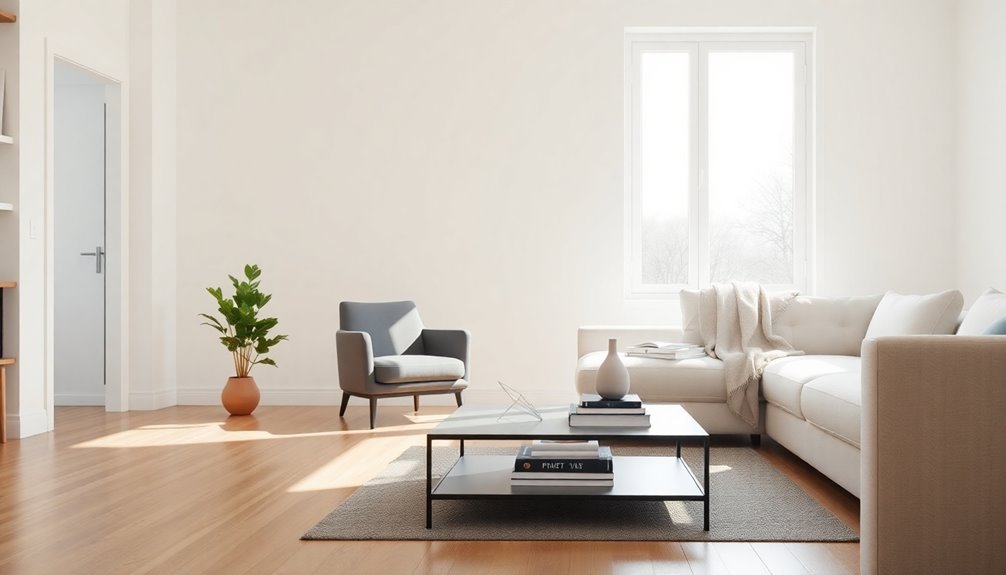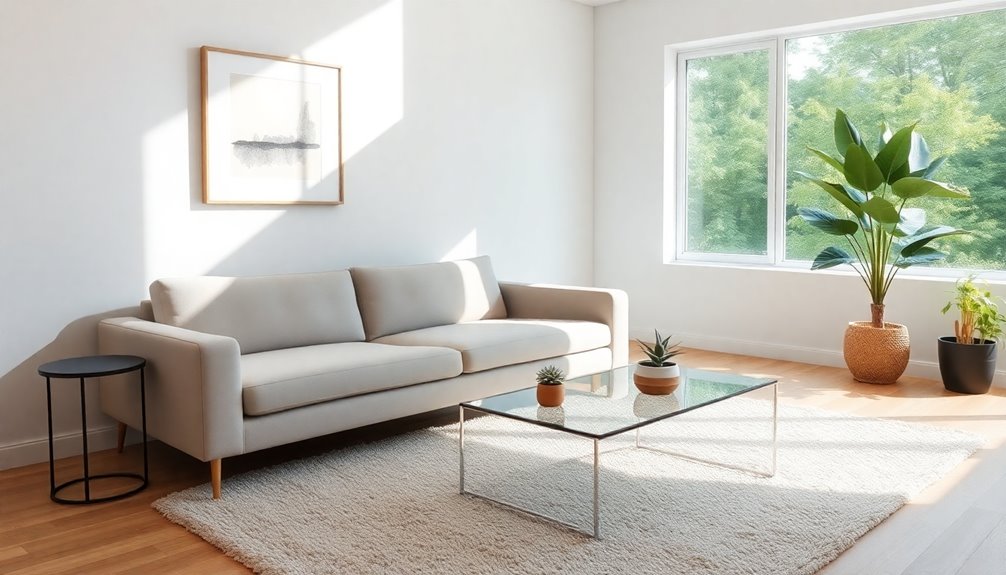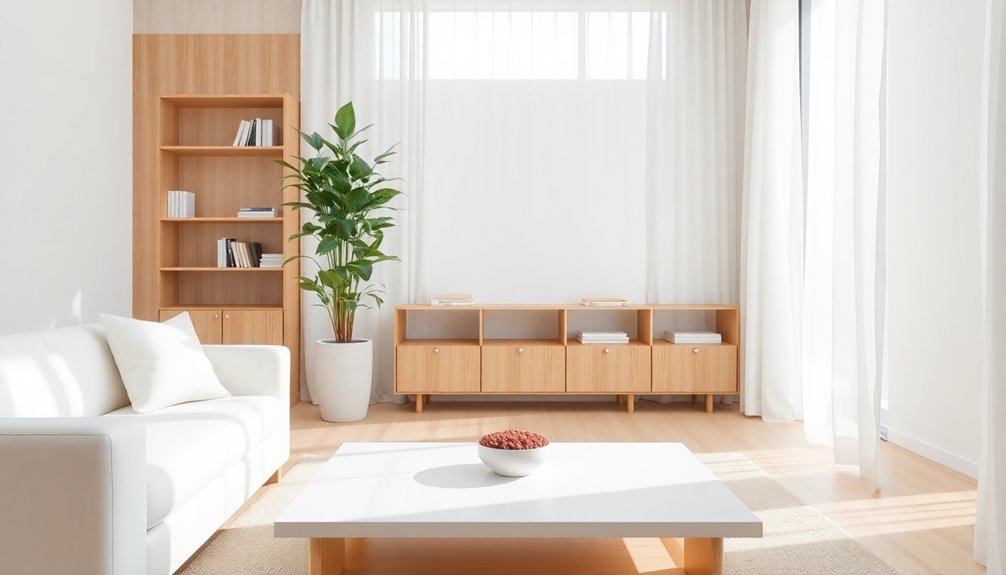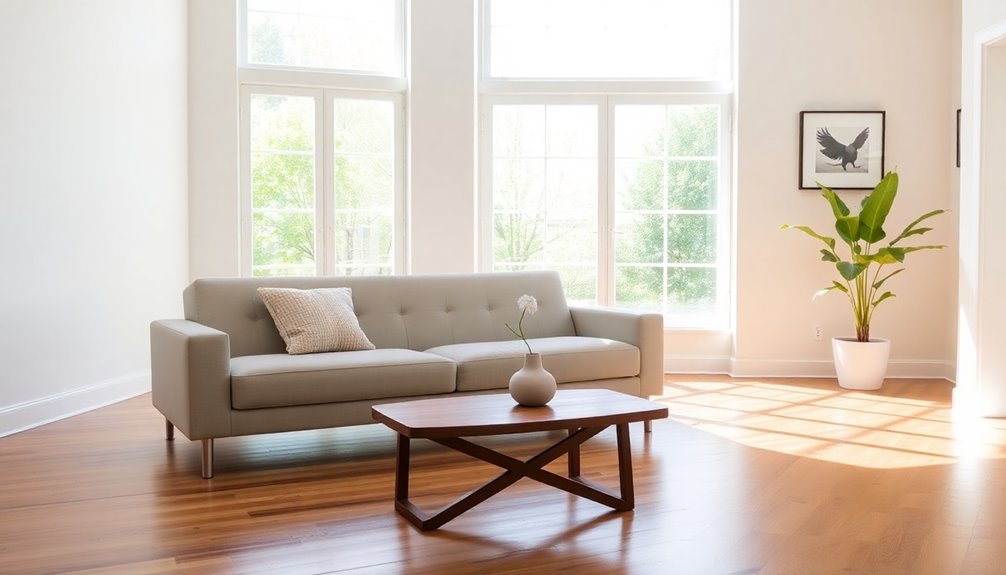To declutter your home for a minimalist lifestyle, start small. Tackle one area at a time, like a drawer or shelf, and set a timer for 5-15 minutes. Use the four-box method: keep, donate, sell, and trash. Recognize emotional attachments and ask yourself why you're keeping certain items. Implement a "one in, one out" rule to prevent future clutter. Celebrate small victories to keep your motivation high. Regular assessments will help maintain your space. If you're keen to explore more effective strategies, you'll discover even greater ways to enhance your journey toward minimalism.
Getting Started With Decluttering
Getting started with decluttering can feel overwhelming, but tackling just a small area can make a big difference. Choose a drawer or shelf and set a timer for just five minutes. In that short time, focus on getting rid of items that don't belong. You'll be surprised at how much you can accomplish!
Before you begin, take a photo of the cluttered space. This visual reminder will motivate you as you work toward transformation. As you sort through your belongings, it's important to identify the emotions tied to your clutter. Understanding why you hold onto certain items will help you make better decisions about what to keep or toss. Consider implementing the touch test to evaluate the significance of items as you declutter. A clutter-free environment promotes mental clarity and can significantly enhance your emotional well-being.
Once you've successfully decluttered that small area, maintain it by regularly reassessing what's there. Implement a "one in, one out" rule to prevent future accumulation. Additionally, using a declutter checklist can help track your progress and keep you focused on your goals.
As you gain confidence, gradually expand your decluttering efforts to adjacent spaces. Celebrate each small victory, and let the momentum carry you forward. Remember, decluttering is a journey, and by starting small, you're setting the stage for a more organized, minimalist lifestyle. Enjoy the process!
Finding Your Minimalist Motivation
To kickstart your minimalist journey, visualize your ideal space and how it would feel to live in it.
Think about the emotional attachments you have to your belongings and why they matter—or don't. By regularly decluttering items based on functionality and necessity, you can create a more peaceful and organized environment. Additionally, consider implementing clothing grouping techniques to simplify your wardrobe and enhance your overall organization. This can include organizing clothing by type and color, which not only streamlines your dressing routine but also enhances the visual appeal of your space.
Visualize Your Ideal Space
Often, visualizing your ideal space can ignite your motivation to embrace a minimalist lifestyle. Picture a serene environment where you can truly relax and focus.
To help with this, take before-and-after photos of your cluttered areas. These images will highlight your transformation and keep you motivated throughout the decluttering process.
Articulate specific reasons for wanting this change—maybe you want to reduce stress or create a more peaceful atmosphere. Write these down and keep them visible.
You might also consider creating a vision board filled with images and quotes that inspire you to maintain a minimalistic living space.
Regularly reflect on how a decluttered environment positively impacts your daily life. Notice how much easier it's to focus on meaningful experiences when you don't have to keep things you don't need.
Additionally, don't hesitate to seek a friend's perspective on your belongings. They can help you objectively assess what no longer serves you.
Identify Emotional Attachments
Many people struggle with emotional attachments to their belongings, which can complicate the decluttering process. These attachments often arise from memories or the perceived value of items, making it essential to reflect on the true purpose of each possession.
Start by asking yourself why you're keeping certain items. Are they genuinely useful, or do they simply evoke nostalgia?
Visual reminders, like before-and-after photos, can motivate you to let go of things that no longer serve a purpose in your life. You might also consider seeking a friend's perspective; they can provide a fresh outlook, helping you assess your emotional attachments with greater objectivity.
Additionally, applying principles from Swedish Death Cleaning encourages you to think about the impact of your possessions on others after you're gone. This perspective can make it easier to part with items that carry unnecessary emotional weight.
Articulate Decluttering Reasons
Recognizing your emotional attachments is just the first step in your decluttering journey; now it's time to articulate your reasons for embracing minimalism. By clearly defining your decluttering reasons, you'll enhance your motivation and commitment to creating a minimalist home.
Reflect on what minimalism means to you and how it can positively impact your life.
Here are a few reasons to contemplate:
- Reducing Stress: A clutter-free space can lead to a calmer mind and a more peaceful environment.
- Creating Functionality: Fewer items mean a more organized and efficient living space, making daily tasks easier.
- Aligning with Values: Minimalism can reflect your beliefs, such as sustainability or simplicity, helping you live in harmony with your principles.
Engage in conversations with family or friends to gain different perspectives on minimalism. Taking before-and-after photos of your decluttered spaces can motivate you and highlight the transformation.
Quick Decluttering Techniques

Decluttering your home doesn't have to be an intimidating task. You can use quick decluttering techniques that fit easily into your daily routine. Start by setting a timer for 15-20 minutes and focus on clearing a single surface or drawer. This focused approach can lead to significant progress without overwhelming you. Regularly assess belongings and donate items not used in the last six months to support sustainability. Implementing a system for regular assessments of cupboard contents can also help maintain order in your space.
Implement the "one in, one out" rule to maintain balance. For every new item you bring into your home, make sure to remove one. This simple strategy helps keep your space minimalistic.
Additionally, try the four-box method: designate boxes for keep, donate, sell, and trash. This makes decision-making clear and organized. Using organizers and bins can further streamline this process.
Consider scheduling short decluttering sessions of just 5 minutes. Tackle different areas of your home gradually to prevent clutter accumulation while maintaining momentum. Establishing good cleaning habits in children can also contribute to a tidier home environment.
Finally, create a dedicated donation bag or box that you fill regularly and take to a donation center promptly. This prevents long-term storage of items meant to be discarded and supports your home organization efforts. Regular reassessment and labeling systems can also enhance your overall organization and efficiency.
Incorporating these quick decluttering techniques can lead to a more organized and serene living space.
Systematic Decluttering Process
Use the "yes or no" rule: Trust your immediate emotional response to each item. If you can't decide quickly whether to keep items, consider letting them go. Maintaining the one-touch rule can help you handle items immediately upon use, reducing clutter.
Maintain a steady pace: Allow yourself breaks to prevent burnout. This consistency will help you commit to a minimalist lifestyle long-term. Establishing a structured cleaning routine can further support your efforts in maintaining a tidy environment.
Celebrate small victories: Acknowledge your progress after decluttering each space. Rewarding yourself can boost motivation and reinforce your commitment. Additionally, creating a visually appealing environment can further enhance your decluttering efforts. Involving family members in the process can also foster a sense of teamwork and shared responsibility, making decluttering less daunting.
As you gain confidence from these initial successes, gradually tackle more cluttered areas. This structured approach not only fosters persistence but also guarantees you're making thoughtful decisions about what to keep in your home.
Maintaining Decluttered Spaces

To keep your decluttered spaces in check, make regular assessments a part of your monthly routine. Schedule specific times to address any new clutter that pops up and celebrate your progress with visual reminders. Implementing time-saving strategies can further enhance your ability to maintain a tidy space without added stress. Additionally, incorporating quick cleaning habits into your daily routine can help sustain a minimalist lifestyle. Staying consistent with these check-ins will help you maintain a tidy and organized environment. Regular organization not only improves accessibility but also enhances mental well-being, allowing for a more serene living space.
Regular Assessments and Check-ins
Maintaining a clutter-free home requires ongoing effort and regular check-ins to guarantee your spaces stay organized. Schedule regular assessments every three months to evaluate how effective your decluttering efforts have been. This helps you adjust your approach and prevents clutter from creeping back in.
Incorporate a routine where you spend 15-20 minutes each week tidying up your decluttered areas. This simple habit assures everything remains in its place. To keep yourself motivated, use visual reminders like before-and-after photos of your spaces.
Here's a quick checklist to guide your assessments:
- Review items not used in the last year for potential donation or disposal.
- Celebrate small victories in maintaining your organized spaces, reinforcing positive habits.
- Keep a checklist of belongings you plan to reassess regularly.
Scheduled Decluttering Sessions
Regular evaluations help you stay on top of clutter, but scheduled decluttering sessions are where the real maintenance happens. To keep your home clutter-free, establish a routine by setting aside time each week or month for these sessions. Mark specific days on your calendar for donating items, reinforcing your commitment to regularly remove excess belongings.
During your scheduled decluttering sessions, set a timer for 15 to 30 minutes. This keeps tasks manageable and helps maintain your motivation to tackle keeping things in order. Focus on evaluating decluttered spaces for any new clutter that may have crept in and dedicate time to tidy up.
Make sure items return to their designated homes to prevent chaos from resurfacing. After each scheduled session, take a moment to celebrate your progress. Acknowledging your accomplishments reinforces the habit of maintaining a clutter-free environment.
Visual Progress Reminders
Visual progress reminders are essential tools that can help you maintain decluttered spaces and stay motivated on your minimalist journey. By visually tracking your achievements, you reinforce your commitment to a clutter-free lifestyle.
Here are some effective strategies to implement:
- Before-and-After Photos: Capture the transformation of your spaces. These images serve as powerful visual reminders of your progress and inspire you to keep going.
- Vision Board: Create a visual representation of your minimalist goals and inspirations. This board keeps your intentions front and center, reminding you of the atmosphere you want to cultivate.
- Journaling: Document your feelings after decluttering. Recording the satisfaction and relief you experience can provide emotional reminders of the benefits of a clutter-free environment.
Incorporate visual reminders throughout your home, like sticky notes or framed quotes, to reinforce your minimalist mindset.
Regularly revisiting these reminders will help sustain your motivation and prevent a return to cluttered habits. With these visual progress reminders, you'll find it easier to maintain the organization and clarity that a minimalist lifestyle brings, ensuring a lasting commitment to your goals.
Creating a Minimalist Mindset
A minimalist mindset transforms your living space into a sanctuary of purpose and clarity. To cultivate this mindset, start by reflecting on the purpose of each item in your home. Ask yourself if it adds value to your life. If not, it's time to let go. A clear goal in this process is to prioritize meaningful experiences over material possessions, which fosters gratitude for the items that genuinely enhance your quality of life.
Next, identify any emotional attachments you have to certain possessions. Recognize that letting go can lead to a more fulfilling and less burdened life. Develop the habit of regularly evaluating your belongings; this makes it easier to resist the urge to accumulate unnecessary items in the future. Incorporating mindfulness techniques, like journaling or meditation, can help you become more aware of clutter triggers. This awareness empowers you to make intentional choices about what you keep. Additionally, utilizing storage solutions can significantly aid in creating a more organized and minimalist environment.
Overcoming Decluttering Challenges

While starting on your decluttering journey, you might encounter emotional barriers that can make the process feel intimidating. Attachment to belongings and fear of future necessity often hold you back, but tackling these feelings head-on is crucial for progress.
Here are some strategies to help you overcome these challenges:
- Break down your decluttering tasks into smaller, manageable segments. Focus on a single drawer or a small area to reduce feelings of overwhelm.
- Seek support from friends or family. Having someone alongside you can boost your motivation and provide valuable perspective.
- Allow for regular breaks to prevent burnout. Short pauses can help you maintain energy and focus throughout your decluttering sessions.
Periodically revisit your decluttering goals to confirm you're aligned with your vision for a minimalist lifestyle. This reflection keeps you committed to your long-term objectives and helps you push through emotional barriers.
Decluttering Specific Areas
Now that you've tackled the initial challenges of decluttering, it's time to focus on specific areas of your home.
Start with your closet by organizing it effectively, streamline your kitchen cabinets for easy access, and don't forget about managing your digital files to reduce clutter on your devices.
Each of these areas can considerably impact your daily life, so let's get started!
Closet Organization Techniques
Many people find that organizing their closet can be a transformative experience in their home decluttering journey. Start by sorting your clothes seasonally. This helps you identify items that are no longer worn or needed each season. Implement the "one in, one out" rule to maintain balance; for every new item you add, remove one to prevent overcrowding.
To enhance your closet organization, consider these techniques:
- Utilize vertical space: Use hanging organizers or shelves to maximize storage efficiency.
- Regularly assess your wardrobe: Aim to donate or dispose of at least 10% of your clothing each year.
- Create a capsule wardrobe: Select versatile pieces that can be mixed and matched, simplifying your choices.
Don't forget to check for expired products, like old accessories or worn-out shoes, that can take up valuable space.
Kitchen Cabinet Streamlining
To streamline your kitchen cabinets effectively, start by emptying them completely. This gives you a clear view of what you have and helps you spot duplicates or items you rarely use.
Once everything's out, sort your items by how often you use them. Keep everyday essentials easily accessible, while stashing less frequently used items in higher or less accessible spaces.
Next, consider donating non-perishable food items and gadgets you haven't used in the past year. This not only reduces clutter but also offers these items a new life.
After decluttering, use labeled storage containers or drawer organizers to categorize your items, like utensils, spices, and baking supplies. This organization makes it a breeze to find what you need without rummaging through everything.
Finally, implement a "one in, one out" rule when you acquire new kitchen items. By following this simple guideline, you can maintain a streamlined cabinet space and prevent future clutter from accumulating.
With these steps, your kitchen won't only look cleaner but also function more efficiently.
Digital File Management
How can you regain control over your digital space? Start by tackling your digital file management. Organizing digital files into clearly labeled folders is essential. Group them by type—like work, personal, or finances—to make access easier and cut down on visual clutter.
Regularly delete or archive outdated documents. Aim to review and clean up your files every three months to prevent unnecessary accumulation.
Here are some strategies to help you stay organized:
- Use cloud storage solutions (like Google Drive or Dropbox) for easy access and backup.
- Implement a consistent naming convention, including dates and keywords, to improve searchability.
- Utilize digital tools or apps, such as Evernote or Trello, to manage tasks and important information.
Incorporating Minimalism Daily

Although minimalism might seem like a challenging lifestyle shift, incorporating it into your daily routine can be both manageable and rewarding. Start by embracing a "one in, one out" rule; every time you bring a new item into your home, remove an existing one. This simple practice helps maintain a clutter-free environment and reinforces mindful consumption.
Next, simplify your shopping habits. Prioritize quality over quantity, focusing on versatile items that serve multiple purposes. This not only enhances your minimalist lifestyle but also saves you money in the long run.
Incorporate daily decluttering rituals into your routine. Spend just 15 minutes tidying up a specific area or eliminating unnecessary items. This consistent effort will cultivate a habit of minimalism and keep your space organized.
Creating a designated drop zone for frequently used items can also streamline organization. This prevents clutter from accumulating in entryways or common areas, making your home feel more serene.
Finally, reflect on your purchases. Ask yourself if they align with your values and needs, reinforcing an intentional living mindset that prioritizes experiences over possessions.
Celebrating Your Achievements
Embracing minimalism brings not only a sense of calm but also a series of accomplishments worth celebrating.
Every step you take towards a decluttered life deserves recognition. Celebrating achievements, no matter how small, can greatly boost your motivation and reinforce the positive feelings associated with decluttering.
To enhance your journey, consider these rewarding practices:
- Create a vision board that visualizes your minimalist goals, serving as a constant reminder of your progress.
- Acknowledge milestones, like completing a room or a specific decluttering task, to enhance your sense of accomplishment.
- Share your success stories with friends or family to inspire others and build a supportive community around the minimalist lifestyle.
Conclusion
As you embrace a minimalistic lifestyle, think of each item you let go as a leaf falling from a tree, making space for new growth. You've cleared clutter, like the gentle breeze that sweeps away the old, revealing a vibrant, open space. Celebrate your journey, for each step forward is a step toward clarity. Keep nurturing this newfound simplicity, and watch as your life flourishes in the light of a decluttered mind and home.